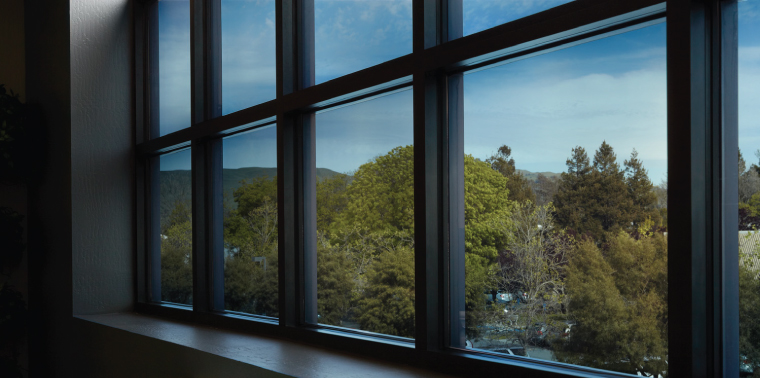September 3, 2013 — We’ve all seen those eyeglasses that change from light to dark depending on how much exposure they get from the sun. Indoors or on cloudy days, they’re clear. In bright sunlight, they’re nearly black.
Now, imagine building windows that adjust from clear to dark like those transition lenses.
That’s exactly what California-based company View is making, with an eye to saving energy — windows that change their tint based on the amount of sun hitting them. Why focus on glass? The majority of energy use in buildings is for heating, cooling or lighting — and windows affect all three.
View windows, which are installed mainly in office buildings and commercial properties, allow natural daylight in while eliminating glare and unwanted heat. But unlike eyeglasses, occupants can control the level of window tint at any moment or automate the windows to change throughout the day depending on sunlight. The glass can reduce air conditioning use by 25 percent and electricity consumption overall for a building by 20 percent, according to View CEO Rao Mulpuri. And, as an added bonus, Mulpuri says, use of the glass is worth 12 points toward LEED building sustainability certification.
“We have built intelligence into the product based on conditions that are changing.” – Rao Mulpuri
View glass isn’t simply a window, though; it’s a system, says Mulpuri, who has a doctorate in materials engineering. The View glass window holds a low-voltage wire that is tied to building management systems, a switch on a wall, or a fully automated system that examines light levels, temperature and whether the room is occupied. “It’s called ‘smart glass’ because we can provide the ability to program this window so you can track the sun, look at the weather and program a window for a given function,” Mulpuri says. “We have built intelligence into the product based on conditions that are changing.”
View glass windows have been installed at the W San Francisco hotel; software company SAP headquarters in Palo Alto; a Starbucks in Denver; East Mississippi Community College in Scooba, Miss.; and the Miramar Marine Corps Air Station in San Diego.
Buildings in the U.S. account for about 40 percent of all U.S. energy consumption, and just over half of that amount is from lighting, heating and cooling.
Compared to high-performing static windows, which cost $5 to $15 per square foot, dynamic glass windows can range from $30 to $100 per square foot. That’s one impediment to the technology, according to environmental energy technologies researcher Arman Shehabi at the Lawrence Berkeley National Laboratory in Berkeley, Calif., who is studying the potential for dynamic glass to be used widely in buildings across the country. “The scalability of dynamic glass has a strong potential once it is more competitive in costs,” he says.
Backers of the technology, such as Mulpuri, argue that the cost is offset by energy savings because the smart glass can be automated, making the best use of daylight to heat a room or blocking light at peak times to cool it. Also, new buildings using dynamic glass windows can get by with smaller heating and air conditioning units, and the fact that windows don’t need blinds or shades offers further savings.
If manufacturing costs can somehow be reduced, Shehabi believes the impact smart glass can have on overall U.S. energy use is immense. Buildings in the U.S. account for about 40 percent of all U.S. energy consumption, and just over half of that amount is from lighting, heating and cooling. “It’s highly variable, but dynamic windows could save on the order of 20 percent of that energy consumption,” Shehabi says.
Shehabi is now studying the newest trend in dynamic glass — blocking near infrared light. “You can’t see the near infrared light, but that contains all the heat,” he says. “Windows that block near infrared allow you to adjust how much heat is coming through but the window stays about the same transparency.”
Opening up an entirely new performance option not previously available with conventional glass windows, dynamic glass could be a major component toward zero-energy buildings — a transition we could all welcome.
![]()
Ensia shares solutions-focused stories free of charge through our online magazine and partner media. That means audiences around the world have ready access to stories that can — and do — help them shape a better future. If you value our work, please show your support today.
Yes, I'll support Ensia!
